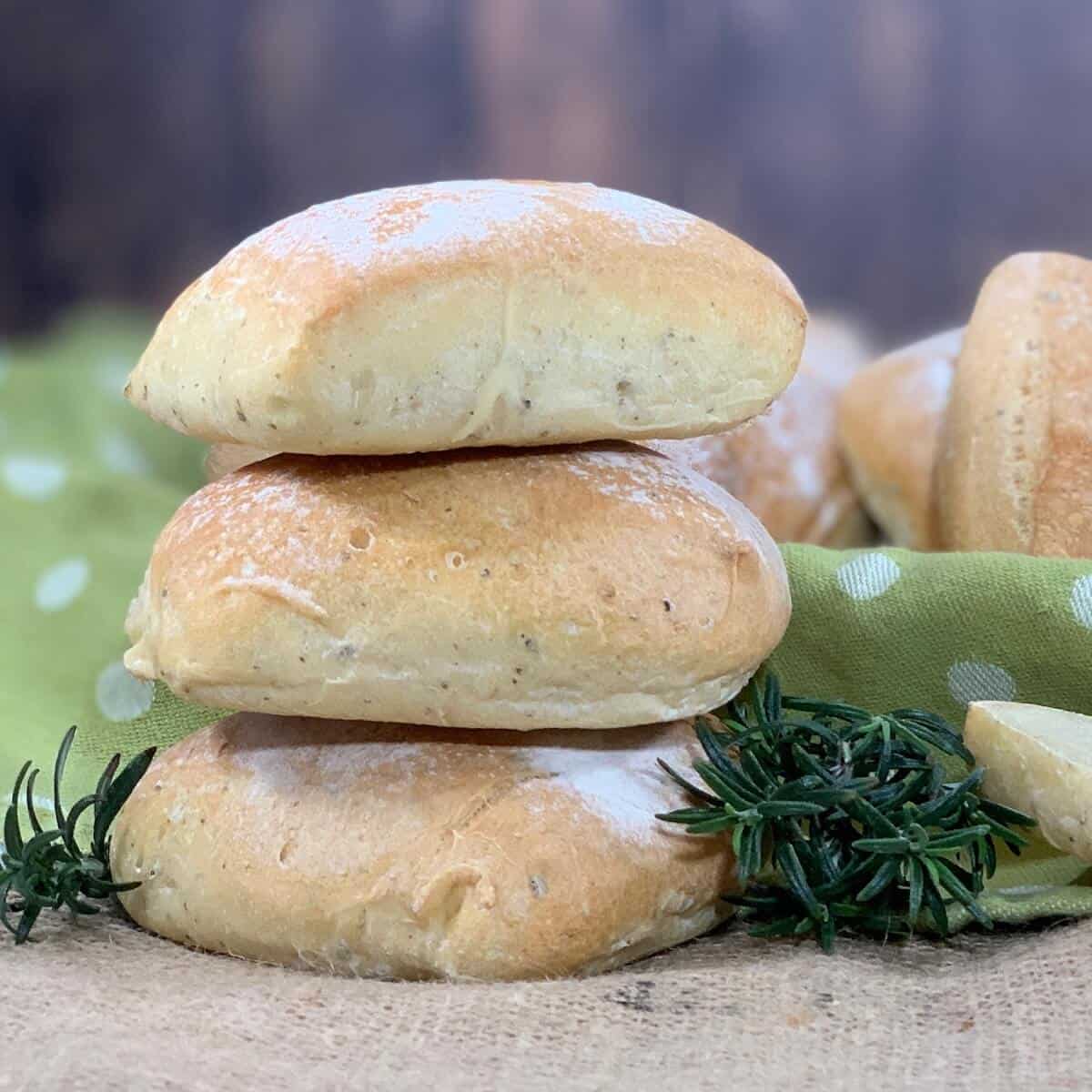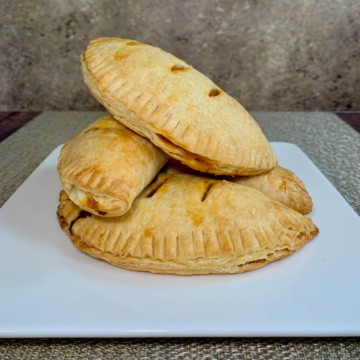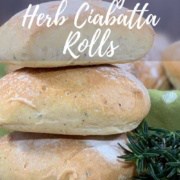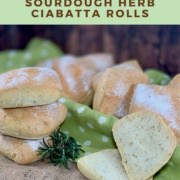These sourdough ciabatta rolls have an assertive herb flavor and subtle sourdough tang, and are perfect to use for sandwiches and paninis, as garlic bread, or just dipped in olive oil. Another great way to use your sourdough starter discard!

Jump to:
Why this recipe works
- These soft and chewy rolls are perfect for sandwiches and paninis, garlic bread, or dipping in olive oil
- Use whatever herbs you’d like to compliment the cuisine you’ll be serving
- Great use of sourdough starter discard
There’s nothing quite like baking bread at home. Combining simple ingredients for dough and watching it puff up, almost by magic. And then there’s that yeasty smell wafting through the house.
Ciabatta bread is a variation on basic bread in that it has a more open, airy interior with a soft, chewy texture and a crunchy crust, and is great when made as rolls. This type of Italian bread is popular for paninis (pressed sandwiches).
And if you maintain a sourdough starter, like I do, then including the sourdough discard in your ciabatta rolls recipe lends a subtle sourdough tang to your bread.
These sourdough discard ciabatta rolls are better than the supermarket's offerings, with an assertive herb flavor coupled with a wonderfully subtle sourdough tanginess. The crackly crust adds a nice contrast to the soft interior.
Use the rolls for sandwiches or paninis, maybe spread with some Pesto al Limone (lemon pesto) or served alongside Briami (aka Greek Ratatouille). Make a delicious garlic bread, or just tear and dip in extra virgin olive oil!
By the way, if you're looking for more uses for unfed sourdough starter, I’ve adapted many sweet and savory recipes to include it. Bagels, pretzels, English Muffins, focaccia, even pumpkin cake and gingerbread are just some of the ways I use my sourdough starter discard.
⭐⭐⭐⭐⭐
First try and they have turned out even better than I imagined. Thank you for this amazing recipe. I used unfed starter and 1- 10 gram piece of fresh cake yeast.
- Kim
Recipe Ingredients
You'll need the following ingredients to make this sourdough discard ciabatta bread recipe:

Ingredient Notes
Flour, water, yeast, salt and a handy 5 : 3 recipe ratio of 5 parts flour to 3 parts water (by weight) - that’s all you need for a basic bread dough. A ciabatta bread recipe has a slightly different recipe ratio with more liquid (up to 5 : 4, flour to water) to get the characteristic open interior (see the FAQs below for more details).
Flour and water: If you want chewier rolls with larger holes, you can add up to ⅓ cup (85 grams) more water, and stir the dough rather than knead it (making it a no-knead ciabatta bread). In order to keep the dough strong enough to handle the increased hydration level, replace the all-purpose flour with bread flour. Working with the dough will be a bit different because it will be so wet, so you'll need different rising and shaping instructions than what is in this recipe.
Sourdough starter discard: Sourdough discard is unfed sourdough starter, i.e. the amount you remove from your crock before feeding the remainder (I do this weekly). Since it's not active starter, it's used for flavor rather than fermentation (you'll need yeast for that).
Yeast: I use instant yeast in all my baking, but you can also use Active Dry yeast. If you use Active Dry yeast, then you might want to sprinkle yeast on to the warmed water with a teaspoon of sugar and allow it to sit for a few minutes before proceeding with the recipe. Letting it foam "proves" the yeast is active and ready to go to work.
If you'd like to omit the yeast and just use fed, active sourdough starter, see the instructions below.
Flavorings: You can use any combination of fresh or dried herbs you prefer - Italian herbs could include rosemary, oregano, basil. Other combinations like sage and thyme or herbs de Provence are lovely as well. Use whatever herbs you’d like to compliment the cuisine you’ll be serving, or leave them out entirely if that's your preference.
See the recipe card for a full list of ingredients and measurements.
How to leave out the commercial yeast
If you don't want to use commercial yeast in this sourdough ciabatta rolls recipe, replace the yeast with ½ cup (114 grams) of active, fed starter, reduce the amount of flour by about ½ cup (57 grams), and reduce the milk by about ¼ cup (57 grams). The rising time will be longer (about double) for both the first and second rises. (Note: there are some rounding inconsistencies here due to the volume vs. weight measurement conversion.)
How to make sourdough ciabatta rolls
Step 1: Make the dough
In the bowl of a stand mixer fitted with a dough hook, stir together 6 cups (720 grams) flour, sourdough starter, water, milk, olive oil, salt, herbs, and yeast. Knead the dough lightly until you have a smooth, slack dough, but not oozy (photo 1).
To achieve a ciabatta’s open, airy interior, the dough needs to be slacker (that is, wetter) than normal bread dough. However, the rolls also need to be able to hold their shape in the oven. Too much flour will yield rolls with a texture that doesn’t have those holes. Not enough flour, and the rolls will just flatten out. Add more flour in two tablespoon increments to get the right dough consistency. This is a trial-and-error process (it depends on lots of local factors like humidity and flour type), so just…uhm…roll with it.

Place the dough in an oiled bowl and cover. Let it rise in a warm spot for about 1 to 2 hours, or until it doubles in size (photo 2). The oven with just the light turned on works well.

Step 2: Portion the dough for rolls
Gently deflate the dough and turn it onto a lightly floured work surface. Pat the dough into a rectangle about 9- x 16-inches. Cut into twelve 3- x 4-inch rolls using a bench scraper or chef’s knife (photo 3). Try to make the rolls approximately the same size, but don’t stress about exact measurements.

Place the rolls on two half sheet baking pans lined with Silpat silicone mats or parchment paper, six to a pan. Space the rolls a little - they'll need room for expansion. Cover the rolls with a towel and let them rise until puffy, about 30 minutes (photo 4).

Step 3: Bake the rolls
While the rolls are rising, preheat the oven to 425 °F. Place a large frying pan filled with water in the bottom of the oven (off to one side). The water will warm while the oven is heating, creating a steamy environment so the crusts get nice and brown. Just be careful when you're opening the oven door - you will get a face full of steam!
Spray the rolls with water and sift a thin layer of flour on top. Bake the rolls for 15 minutes, then rotate the baking sheets, working quickly to avoid losing steam. Lower the oven temperature to 375 °F and bake for an additional 15 to 20 minutes, until the rolls are a deep golden brown (photo 5).
Remove the rolls from the oven, turn off the oven, and return the rolls to the oven with its door cracked open a couple of inches. Let rolls cool completely in the cooling oven.

Storage instructions
Cooled ciabatta rolls can be stored in an airtight container at room temperature for 3 to 4 days, or frozen in an airtight bag for up to 3 months.
Questions asked and answered
Here are some questions you might have...
Ciabatta bread is characterized by an open, airy interior, chewy texture, and a crunchy, crackly exterior. That is achieved by having a slacker (wetter) dough with a higher hydration level (that is, the recipe ratio or the amount of flour to water in the recipe) than standard bread dough.
The recipe ratio for normal bread is 5 : 3, flour to water, giving it a 60% hydration level. The hydration level for this sourdough ciabatta recipe is almost 70%, giving these rolls that open interior we're looking for, yet with enough structure to make a solid sandwich roll.
The large holes in ciabatta rolls are the result of the water evaporating as the dough bakes. The higher the hydration level, the more holes you'll get. A no-knead bread recipe has a high hydration level (up to 80%, a 5 : 4 recipe ratio, flour to water), and you only have to whisk the ingredients together before the first rise.
To get that nice crispy, crackly exterior on the rolls, add steam to the oven. You can use the skillet-and-water method described above, or you can cover the rolls with a large aluminum roasting pan (the disposable rectangular kind for roasting turkeys) for 15 minutes during baking (remove the pan when you lower the oven temperature). Just be careful when opening the oven door (or removing the pan) - you will get a face full of steam.


More recipes featuring sourdough discard to try
Recipe

Sourdough Herb Ciabatta Rolls
Equipment
- large frying pan
- spray bottle
Ingredients
- 6 to 7 cups all-purpose flour, see Recipe Notes
- 1¼ cups water, warmed between 100°F to 110°F, see Recipe Notes
- 1 cup sourdough starter discard, fed or unfed, room temperature, see Recipe Notes
- ¾ cup milk, warmed between 100°F to 110°F
- 1 tablespoon extra virgin olive oil
- 1 tablespoon kosher salt
- 1 tablespoon mixed herbs, chopped, see Recipe Notes
- 2 teaspoons instant yeast, or Active dry, see Recipe Notes
Instructions
- In the bowl of a stand mixer fitted with a dough hook, stir together 6 cups (720 grams) flour, water, sourdough starter, milk, olive oil, salt, herbs, and yeast.
- Knead the dough lightly until you have a smooth, slack dough, but not oozy. If necessary, add more flour in two tablespoon increments to get the right dough consistency.
- Place the dough in an oiled bowl and cover. Let it rise in a warm spot for about 1 to 2 hours, or until it doubles in size (the oven with just the light turned on works well).
- Gently deflate the dough and turn it onto a lightly floured work surface. Pat the dough into a rectangle about 9- x 16-inches. Cut into twelve 3- x 4-inch rolls using a bench scraper or chef’s knife. Try to make the rolls approximately the same size, but don’t stress about exact measurements.
- Place the rolls on two half sheet baking pans lined with Silpat silicone mats or parchment paper, six to a pan. Space the rolls a little - they'll need room for expansion. Cover the rolls with a towel and let them rise until puffy, about 30 minutes.
- While the rolls are rising, preheat the oven to 425 °F. Place a large frying pan filled with water in the bottom of the oven (off to one side). The water will warm while the oven is heating, creating a steamy environment so the crusts get nice and brown. Just be careful when you're opening the oven door - you will get a face full of steam!
- Spray the rolls with water and sift a thin layer of flour on top. Bake the rolls for 15 minutes, then rotate the baking sheets, working quickly to avoid losing steam. Lower the oven temperature to 375 °F and bake for an additional 15 to 20 minutes, until the rolls are a deep golden brown.
- Remove the rolls from the oven, turn off the oven, and return the rolls to the oven with its door cracked open a couple of inches. Let rolls cool completely in the cooling oven.
- Storage instructions: Cooled ciabatta rolls can be stored in an airtight container at room temperature for 3 to 4 days, or frozen in an airtight bag for up to 3 months.













Dennis O'Flynn says
Are the electric oven temperatures fan forced or conventional?
Tammy Spencer says
Hi Dennis, the oven temperatures mentioned are for a conventional oven. If your oven is convection, you should reduce the oven temperature by 25 °F (-4 °C), and keep an eye on the rolls towards the end of the baking time. Happy baking! 😉
Kim Rozwadowski says
First try and they have turned out even better than I imagined. Thank you for this amazing recipe. I used unfed starter and 1- 10 gram piece of fresh cake yeast.
Tammy says
Hi Kim, I'm so glad you liked this recipe. Enjoy! 😉
Shira says
Looks delicious! I can’t wait to try!
Tammy says
Thanks, Shira! 😉